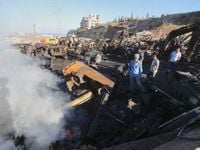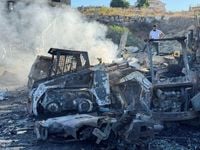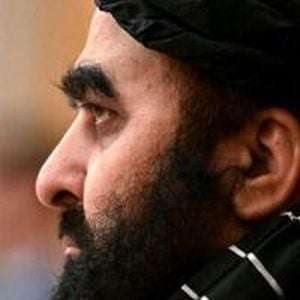In the early hours of October 11, 2025, the quiet of southern Lebanon was shattered by a barrage of Israeli airstrikes targeting the village of Msayleh. The strikes, which Israeli officials say were aimed at Hezbollah’s efforts to rebuild its military infrastructure, left one Syrian national dead and seven others wounded—including six Lebanese citizens, two of whom were women. The attack also destroyed a site selling heavy machinery, obliterating numerous vehicles and briefly severing a key highway linking Beirut to the south, according to the Lebanese Health Ministry, as reported by the Associated Press and Al Jazeera.
Eyewitness accounts and footage circulating on social media captured the aftermath: a plume of orange smoke billowing over the wreckage of what had once been a bustling machinery lot. In a tragic twist of fate, a passing vegetable truck was struck during the bombardment, resulting in the lone fatality and one of the injuries. The violence, which has become an almost daily occurrence since the end of the 14-month Israel-Hezbollah war in November 2024, underscores the region’s fragile peace and the deep scars left by years of conflict.
The Israeli Defense Forces (IDF) justified the operation, stating on social platform X that their air force had targeted “engineering machinery used by Hezbollah to reestablish terrorist infrastructure in violation of agreements between Israel and Lebanon.” The IDF further asserted, “The Hezbollah terror organization continues in attempts to rehabilitate terror infrastructure throughout Lebanon, while endangering Lebanese civilians and using them as human shields.” According to the IDF, such actions constitute a violation of longstanding understandings between the two countries, and the military vowed to “continue to operate in order to protect the State of Israel.”
Lebanon’s response was swift and unequivocal. President Joseph Aoun condemned the strikes as a “heinous Israeli aggression against civilian installations—without justification or pretext,” emphasizing the gravity of the attack given its timing in the wake of a newly brokered ceasefire in Gaza. “The seriousness of this latest attack lies in the fact that it comes after the ceasefire agreement in Gaza,” Aoun stated, echoing widespread concerns that the violence threatened to unravel recent diplomatic gains. The Lebanese Cabinet, while under significant international pressure, has reiterated its willingness to aid in the disarmament of Hezbollah, but only if Israel halts its hostilities—a demand that remains unmet as strikes persist.
The recent airstrikes are part of a broader pattern that has unfolded since the U.S.-brokered ceasefire ended major hostilities between Israel and Hezbollah in late November 2024. Despite the truce, Israeli forces have carried out near-daily attacks, claiming to target Hezbollah’s attempts to recover from the substantial losses it sustained during the war. The United Nations human rights chief, Volker Türk, reported at the start of October that at least 103 civilians have been killed in Lebanon by Israeli strikes since the ceasefire took effect. Israeli forces, meanwhile, remain stationed at several positions inside Lebanese territory, a lingering reminder of the conflict’s unresolved issues.
The roots of the current escalation can be traced back to October 7 and 8, 2023, when a Hamas-led incursion into southern Israel killed 1,200 Israelis and saw more than 250 people taken hostage. In response, Hezbollah launched rockets into northern Israel, sparking a 14-month war that would claim over 4,000 lives in Lebanon—including hundreds of civilians—and cause an estimated $11 billion in destruction, according to the World Bank. Israel, for its part, suffered 127 deaths, 80 of them soldiers.
As the dust settles from each successive strike, the political and humanitarian fallout continues to reverberate. The latest attack came just days after Israel and Hamas agreed to the first stages of a 20-point peace plan to end the ongoing war in Gaza. The plan, unveiled by President Trump and supported by U.S. soldiers stationed in Israel to oversee its implementation, includes a ceasefire and an exchange of remaining hostages and Palestinian prisoners. President Aoun lauded the agreement, calling for “continued international and regional efforts to achieve a comprehensive and just peace in the region that guarantees the legitimate rights of the Palestinian people.” He also urged Israel to “halt its aggressive policies in Palestine, Lebanon, and Syria.”
The complexity of the situation is further compounded by internal Lebanese dynamics. Hezbollah, designated a terrorist organization by the U.S. but also a powerful political force within Lebanon, has steadfastly refused calls to disarm. At a recent commemoration for former Hezbollah leader Hassan Nasrallah, current secretary-general Naim Qassem declared to supporters that the group would “never relinquish its weapons.” U.S. special envoy Tom Barrack acknowledged the challenge, telling Al Jazeera that “convincing Hezbollah to disarm is the job of the Lebanese government,” but he conceded that the organization’s political legitimacy complicates any disarmament efforts. In early September, under mounting U.S. and Israeli pressure, the Lebanese government tasked its army with preparing a plan to disarm Hezbollah—a move that has yet to yield tangible results.
The security situation remains tense. Lebanese authorities recently arrested 32 people suspected of collaborating with Israel by providing intelligence on Hezbollah, facilitating targeted strikes. Nine of those suspects have already been tried by military court, with 23 still under investigation. Lebanon, which maintains no formal ties with Israel, treats such contact as a criminal offense punishable by imprisonment.
Meanwhile, the humanitarian consequences of the ongoing violence are mounting. The destruction of infrastructure, such as the highway linking Beirut to the south, has hampered movement and complicated relief efforts. The United Nations has outlined plans to deliver vital humanitarian aid across Gaza, where the ceasefire has allowed thousands of Palestinians to return to their devastated homes. Yet in Lebanon, the near-daily strikes have left many civilians living in fear, uncertain when or where the next attack might land.
As the region grapples with the aftermath of war and the fragile promise of peace, the events in Msayleh serve as a stark reminder of the volatility that still grips southern Lebanon. With diplomatic efforts ongoing and the threat of renewed hostilities ever-present, the stakes for both sides—and for the civilians caught in the crossfire—remain perilously high.
For now, the battered landscape of southern Lebanon stands as a testament to the enduring cost of conflict and the urgent need for a lasting resolution.





